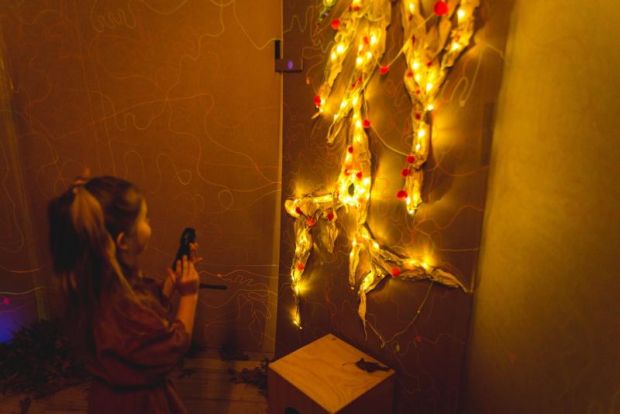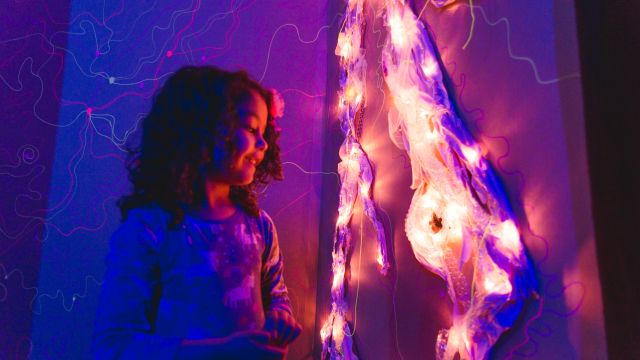Wood Wide Web
How do trees grow? Do trees support each other? How? Do trees talk to each other? This interactive installation for 3- to 5-year-olds sets out to answer those questions in the most accessible – and, to watch the kids, exciting - way. In other words, science is rendered tangible, a matter of cause and effect, and an experience in which the children themselves are helpers. It is theatre of the most interactive and ‘immersive’ kind.
We (kids, parents and carers, and observers) are shepherded into a space surrounded by low benches. A big screen has a projection of various fungi growing, spreading, falling over – like living things, which indeed is what they are. As we settle down to very small child height, we are greeted by two ‘play specialists’, Laura Aldous and Callum Cheah. While Callum has a kindly reassuring presence, Laura does most of the talking. She has a certain indefinable quality I’ll call ‘magic’ that gets the kids to trust her immediately and to hang on her every word. She shows her audience about what trees need – minerals, nutrients, and water – and the fungi we can all see on the screen. Then she gets the kids to make an insect out of foam, pipe cleaners, feathers, and bits of plastic. Parents and carers may assist. With nary a word of protest, the kids go to it and proudly show the results. Some kids are shy, some boisterous, but all are involved.

Yes, sure, it’s ‘educational’ with a serious environmental ‘message’ – and it’s also a metaphor about human collaboration. It’s coming off such recent books as The Hidden Life of Trees and The Heartbeat of Trees by Peter Wohlleben. But, rather than a passive ‘learning experience’, Wood Wide Web is structured as a series of tasks, each of which must be achieved in sequence by the kids and each of which has a visible and audible result.
Laura and Callum issue the kids with ‘minerals’ and tell them to find the baby trees and feed them the minerals. And so we enter the installation proper. We are under the earth, down among the tree roots and fungi, a series of tunnels and passages (we adults can see it’s all made of strong cardboard, but it’s not for adults; it’s for kids who bring their imaginations and wonder with them). There are UV sensitive swirls of root systems and quietly rumbling sound.
The kids plunge fearlessly into the tunnels. They discover that the trees talk (the voices of Laura, Callum, Nicole Harvey and Justine Warner) and that the kids can talk back! The trees deliver ‘nutrients’ into the kids’ hands - and the next task is to feed the nutrients into other root systems – that sparkle up in a shower of lights. The kids are delighted, elated – and the trees say, ‘thank you’.

Like other Barking Spider experiences conceived for children, Wood Wide Web is entrancing and active; the participants are drawn in, and eagerly embrace ways of doing and thinking that most likely they have not met before. Artistic Director of Barking Spider, Penelope Bartlau, in particular, is able to ‘make herself small’, to think and feel in a childlike way, and then, with her talented collaborators, to render that into a concrete experience for children, always involving them doing things, discovering things, and not even noticing that they’re learning things about the world and themselves. Wood Wide Web is now over in this location. So much work and thought for just nine forty-five-minute experiences. Let’s hope it pops up elsewhere soon.
Michael Brindley
Subscribe to our E-Newsletter, buy our latest print edition or find a Performing Arts book at Book Nook.

